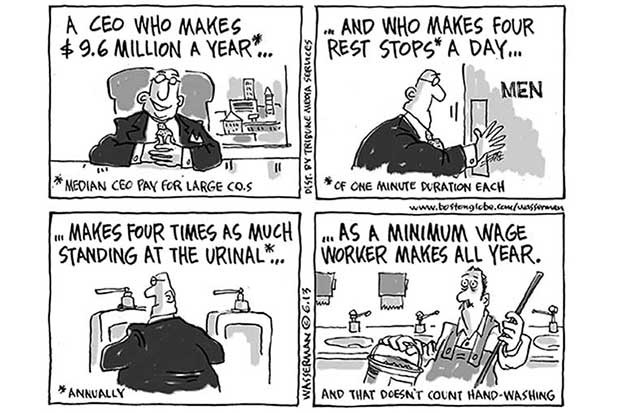The American Dream Is Built on Fair Wages
We built our business on wages above the minimum. For this small extra investment, we get long-term employees who are devoted to our company – employees whose ongoing relationships with customers have been vital to our success.
Good wages have been good business strategy in an industry that has seen more than its share of creative destruction. The last 20 years have been tough on the music business. In St. Louis, two-thirds of the record stores have closed since 2000. We’ve outlasted a 20-store local chain and numerous national and regional chains. Most of those companies paid their employees minimum wage or barely above. My creative, dedicated and better-paid employees won this life or death struggle for us.
Higher wages made us more competitive – not less. While my competition dealt with the costly results of constant employee turnover, constant training costs and the unsatisfied customers that turnover breeds, my employees added great value to my business.
Unfortunately, too many American companies have been driving down wages to poverty levels that are too low for workers to live on and too low to sustain the consumer demand that businesses need to survive and thrive. In a race to the bottom, the winner ends up at the bottom. The American Dream needs a minimum wage increase.
The current federal minimum wage of $7.25 an hour, just $15,080 for full-time work, is too low a floor under our workforce, our customers and our economy. Back in 1979, when we started our company, the minimum wage was $2.90 – that would be $9.33 in today’s dollars. Even back then, it had eroded from the 1968 minimum wage level, which would be $10.74 adjusted for inflation.
We never would have believed that 34 years later, the buying power of minimum wage workers – and millions of workers above minimum wage – would actually be lower than when we started our company. That’s terrible for small business, terrible for our economy and terrible for our country.
There’s a proposal in Congress to gradually raise the minimum wage to $10.10 over three years and then adjust it annually for inflation in the years following. It’s a reasonable proposal that moves us closer to where we would have been if the minimum wage had kept up with inflation since the 1960s.
Small business owners know that higher minimum wages put spendable dollars into the hands of our customers. Minimum wage earners, who live from paycheck to paycheck, spend increases right away. Putting a few hundred dollars more a month in their pockets would be a needed boon to business and the economy.
Companies that pay poverty wages count on other businesses and taxpayers to subsidize them. You may think of food stamps, housing assistance and child care subsidies as helping the poor, and they do, and it’s essential that we maintain them. But when wages are so low that full-time workers need the public safety net to put food on the table or keep a roof overhead, we are actually subsidizing the unrealistically low wages paid mostly by big highly profitable corporations. This perverts capitalism and is lousy public policy.
For example, in my state, according to the MO Healthnet Employer Report, in the first quarter of 2012 (latest data available) Walmart alone cost $6,247,032 in Medicaid costs. McDonalds cost $4,050,360 and Casey’s General Stores cost $1,473,094. Subway, Pizza Hut, Taco Bell and Sonic Restaurants cost more than $1 million dollars each. Together, these seven low-wage companies cost more than $16 million in Missouri taxpayer money in just three months.
A crucial part of my job as CEO is prediction and planning. Part of that is predicting costs and demand. Indexing the minimum wage to inflation, as Missouri and nine other states do now, would make it easier for businesses to predict and plan for labor costs. It would mean the buying power of our customers would not be hollowed out by an eroded wage floor.
Indexing is good for our tax base and our school systems, which are so dependent on property taxes. The most local small business is landlord. Most rental units are locally owned. The vast majority of low-wage workers are renters. A decent minimum wage helps maintain healthy property values and tax revenues.
The evidence that trickle-down economics doesn’t work is all around us. People are falling out of the middle class instead of rising into it. Putting money in the hands of people who desperately need it to buy goods and services will give us a trickle-up effect. Raising the minimum wage is a really efficient way to circulate money in the economy from the bottom up where it can have the most impact in alleviating hardship and boosting demand at businesses.
The American Dream isn’t functioning when the pie gets bigger, but the share for working people shrinks. Decent wages at the lowest rungs lets workers make ends meet while giving them a taste of the rewards of work.
Let’s keep the American Dream in sight for those farthest from experiencing its sweetest fruits.
Lew Prince is co-owner and CEO of Vintage Vinyl in St. Louis, Mo., and member of Business for a Fair Minimum Wage.



Leave a Reply
Want to join the discussion?Feel free to contribute!